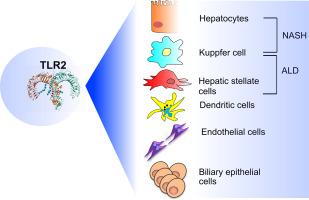Our official English website, www.x-mol.net, welcomes your
feedback! (Note: you will need to create a separate account there.)
Toll-like receptor 2 signaling in liver pathophysiology
Life Sciences ( IF 5.2 ) Pub Date : 2021-09-08 , DOI: 10.1016/j.lfs.2021.119941 Anteneh Getachew 1 , Muzammal Hussain 2 , Xinping Huang 1 , Yinxiong Li 3
Life Sciences ( IF 5.2 ) Pub Date : 2021-09-08 , DOI: 10.1016/j.lfs.2021.119941 Anteneh Getachew 1 , Muzammal Hussain 2 , Xinping Huang 1 , Yinxiong Li 3
Affiliation

|
Chronic liver diseases (CLD) are among the major cause of mortality and morbidity worldwide. Despite current achievements in the area of hepatitis virus, chronic alcohol abuse and high-fat diet are still fueling an epidemic of severe liver disease, for which, an effective therapy has yet not been discovered. In particular, the therapeutic regimens that could prevent the progression of fibrosis and, in turn, aid cirrhotic liver to develop a robust regenerative capability are intensively needed. To this context, a better understanding of the signaling pathways regulating hepatic disease development may be of critical value. In general, the liver responds to various insults with an orchestrated healing process involving variety of signaling pathways. One such pathway is the TLR2 signaling pathway, which essentially regulates adult liver pathogenesis and thus has emerged as an attractive target to treat liver disease. TLR2 is expressed by different liver cells, including Kupffer cells (KCs), hepatocytes, and hepatic stellate cells (HSCs). From a pathologic perspective, the crosstalk between antigens and TLR2 may preferentially trigger a distinctive set of signaling mechanisms in these liver cells and, thereby, induce the production of inflammatory and fibrogenic cytokines that can initiate and prolong liver inflammation, ultimately leading to fibrosis. In this review, we summarize the currently available evidence regarding the role of TLR2 signaling in hepatic disease progression. We first elaborate its pathological involvement in liver-disease states, such as inflammation, fibrosis, and cirrhosis. We then discuss how therapeutic targeting of this pathway may help to alleviate its disease-related functioning.
中文翻译:

肝脏病理生理学中的 Toll 样受体 2 信号转导
慢性肝病(CLD)是全世界死亡和发病的主要原因之一。尽管目前在肝炎病毒领域取得了一定的成就,但长期酗酒和高脂肪饮食仍然助长了严重肝病的流行,且尚未找到有效的治疗方法。特别是,迫切需要能够预防纤维化进展并进而帮助肝硬化肝脏发展强大的再生能力的治疗方案。在这种情况下,更好地了解调节肝病发展的信号通路可能具有至关重要的价值。一般来说,肝脏通过涉及各种信号通路的精心策划的愈合过程来应对各种损伤。其中一种通路是 TLR2 信号通路,它本质上调节成人肝脏的发病机制,因此已成为治疗肝病的一个有吸引力的靶点。 TLR2 由不同的肝细胞表达,包括库普弗细胞 (KC)、肝细胞和肝星状细胞 (HSC)。从病理学角度来看,抗原和 TLR2 之间的串扰可能会优先触发这些肝细胞中一组独特的信号传导机制,从而诱导炎症和纤维化细胞因子的产生,从而引发和延长肝脏炎症,最终导致纤维化。在这篇综述中,我们总结了有关 TLR2 信号传导在肝病进展中的作用的当前可用证据。我们首先详细阐述其在肝脏疾病状态(例如炎症、纤维化和肝硬化)中的病理参与。然后我们讨论该通路的治疗靶向如何有助于减轻其与疾病相关的功能。
更新日期:2021-09-08
中文翻译:

肝脏病理生理学中的 Toll 样受体 2 信号转导
慢性肝病(CLD)是全世界死亡和发病的主要原因之一。尽管目前在肝炎病毒领域取得了一定的成就,但长期酗酒和高脂肪饮食仍然助长了严重肝病的流行,且尚未找到有效的治疗方法。特别是,迫切需要能够预防纤维化进展并进而帮助肝硬化肝脏发展强大的再生能力的治疗方案。在这种情况下,更好地了解调节肝病发展的信号通路可能具有至关重要的价值。一般来说,肝脏通过涉及各种信号通路的精心策划的愈合过程来应对各种损伤。其中一种通路是 TLR2 信号通路,它本质上调节成人肝脏的发病机制,因此已成为治疗肝病的一个有吸引力的靶点。 TLR2 由不同的肝细胞表达,包括库普弗细胞 (KC)、肝细胞和肝星状细胞 (HSC)。从病理学角度来看,抗原和 TLR2 之间的串扰可能会优先触发这些肝细胞中一组独特的信号传导机制,从而诱导炎症和纤维化细胞因子的产生,从而引发和延长肝脏炎症,最终导致纤维化。在这篇综述中,我们总结了有关 TLR2 信号传导在肝病进展中的作用的当前可用证据。我们首先详细阐述其在肝脏疾病状态(例如炎症、纤维化和肝硬化)中的病理参与。然后我们讨论该通路的治疗靶向如何有助于减轻其与疾病相关的功能。











































 京公网安备 11010802027423号
京公网安备 11010802027423号